|
State Academic Chapel
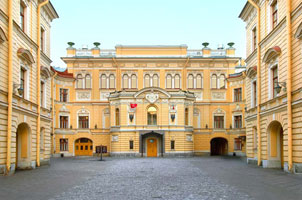 The state Academic Chapel takes a special place in a history of culture of Russia. This first musical - professional establishment. Rovesnitsa Saint Petersburg (the 300-anniversary of city will be marked in 2003). Survived with the city becoming and blossoming, difficulties and pleasures, the Chapel became the center of formation of Russian professional music. Here created Bortnjansky, Glinka, Lvov, Balakerev, Roman - Korsakov, Ljadov, Arensky, and other Russian composers, were laid by noble efforts and oustanding which achievements of a way of development of Russian music as arts deeply national, original on spirit and language. Here, in the glorified Chapel, immortal creations Chajkovskogo, Rahmaninova, Borodino, Musorskogo, Glazunova, Shstakovicha, Prokof‘eva, Sviridova sounded.. .. But the Chapel is especial also that represents unique, not having analogues in the world the musical establishment uniting concert, musical - educational and educational activity. The chapel shows remarkable synthesis of chorus, a symphonic orchestra, an educational institution and a magnificent hall with body that allows to carry out grandiose creative plans. Words of composer Gektora Berlioza, of 19 centuries which have visited in middle Saint Petersburg are known: " This Chapel is bettest existing and, maybe, once than existing similar establishments in Europe ".
The state Academic Chapel takes a special place in a history of culture of Russia. This first musical - professional establishment. Rovesnitsa Saint Petersburg (the 300-anniversary of city will be marked in 2003). Survived with the city becoming and blossoming, difficulties and pleasures, the Chapel became the center of formation of Russian professional music. Here created Bortnjansky, Glinka, Lvov, Balakerev, Roman - Korsakov, Ljadov, Arensky, and other Russian composers, were laid by noble efforts and oustanding which achievements of a way of development of Russian music as arts deeply national, original on spirit and language. Here, in the glorified Chapel, immortal creations Chajkovskogo, Rahmaninova, Borodino, Musorskogo, Glazunova, Shstakovicha, Prokof‘eva, Sviridova sounded.. .. But the Chapel is especial also that represents unique, not having analogues in the world the musical establishment uniting concert, musical - educational and educational activity. The chapel shows remarkable synthesis of chorus, a symphonic orchestra, an educational institution and a magnificent hall with body that allows to carry out grandiose creative plans. Words of composer Gektora Berlioza, of 19 centuries which have visited in middle Saint Petersburg are known: " This Chapel is bettest existing and, maybe, once than existing similar establishments in Europe ".
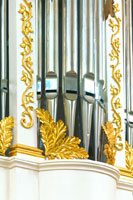 Really, at the end of 19-beginning 20 v.v. The chapel becomes one of the largest musical centres of Europe. The basis on which generated this remarkable phenomenon of domestic culture there was the Singing Chapel originating even ince 1479. Then under the decree of grand Duke Ivan III in Moscow the chorus kings singing clerks, becoming was founded by a cradle of Russian choral art. In Peter‘s I epoch choral singing was an integral part of court culture. Any business began with the common prayful singing. In all campaigns, in days of celebrations and Peter‘s I everyday lives accompanied with " Singing houses of his Majesty" - so singing clerks are called in documents of the beginning of century kings. The King payed the big attention of the singing brotherhood. A lot of time carried spent in their society, cared of their life, itself watched duly updating of creative structure and quite often took part in singing, executing a set of a bass. Accompanied with Peter I chorus and in May, 1703 when in a mouth of Neva the first stones were put in the basis of new capital of Russian state. The thunder of the cannon salutes which have announced birth of Saint Petersburg, has merged that day with a toast in glory of new Russian capital which was sung by 28 court choristers. So the Chapel of Saint Petersburg started the biography. " Kapeliej court choristers "or" court Kapeliej " chorus began to name during Elizaveta Petrovny‘s reign. It print from the name of the vokaled-tool collectives serving at the European court yard.
Really, at the end of 19-beginning 20 v.v. The chapel becomes one of the largest musical centres of Europe. The basis on which generated this remarkable phenomenon of domestic culture there was the Singing Chapel originating even ince 1479. Then under the decree of grand Duke Ivan III in Moscow the chorus kings singing clerks, becoming was founded by a cradle of Russian choral art. In Peter‘s I epoch choral singing was an integral part of court culture. Any business began with the common prayful singing. In all campaigns, in days of celebrations and Peter‘s I everyday lives accompanied with " Singing houses of his Majesty" - so singing clerks are called in documents of the beginning of century kings. The King payed the big attention of the singing brotherhood. A lot of time carried spent in their society, cared of their life, itself watched duly updating of creative structure and quite often took part in singing, executing a set of a bass. Accompanied with Peter I chorus and in May, 1703 when in a mouth of Neva the first stones were put in the basis of new capital of Russian state. The thunder of the cannon salutes which have announced birth of Saint Petersburg, has merged that day with a toast in glory of new Russian capital which was sung by 28 court choristers. So the Chapel of Saint Petersburg started the biography. " Kapeliej court choristers "or" court Kapeliej " chorus began to name during Elizaveta Petrovny‘s reign. It print from the name of the vokaled-tool collectives serving at the European court yard.
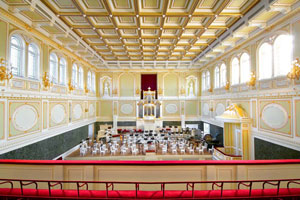 A little bit later, in 1763 at Ekaterina II, behind it the name " the Court singing Chapel " was fixed. Life of the Chapel of XVIII century is evident display of the European orientation of the government of Russia. The quantity of court choristers is promptly increased. If per 1743 in structure of court chorus entered 37 choristers, into 1748 - them 57, and in 1764 - 72 persons (40 adult, 31 juvenile choristers and 1 header). The repertoir of chorus, and also sphere of its performing activity gradually varies and extends. Elizaveta Petrovna zealously concerned to church service and tested great pleasure from church music in which it was trained from youth. In a palace except for a small court chapel near to apartments of empress there was for daily services a second small chapel. In it there was a special board behind which empress participated in singing together with female a mansion. Wishing to keep style of Russian sacred music, she did not resolve in again composed spiritual singning mixture with the Italian style, so actively taking root in court music of Russia. But at the same time, from Elizaveta‘s times court chorus start to use in theatrical statements and chamber musicianated. For the first time court church choristers were entered into two choruses of the Italian opera "Klimentina" put on the occasion of crowning of empress Elizaveta in 1742. In Elizaveta Petrovny‘s birthday the chorus of court choristers acts in the beginning of 50th years at a court yard already with performance of the Italian music.
A little bit later, in 1763 at Ekaterina II, behind it the name " the Court singing Chapel " was fixed. Life of the Chapel of XVIII century is evident display of the European orientation of the government of Russia. The quantity of court choristers is promptly increased. If per 1743 in structure of court chorus entered 37 choristers, into 1748 - them 57, and in 1764 - 72 persons (40 adult, 31 juvenile choristers and 1 header). The repertoir of chorus, and also sphere of its performing activity gradually varies and extends. Elizaveta Petrovna zealously concerned to church service and tested great pleasure from church music in which it was trained from youth. In a palace except for a small court chapel near to apartments of empress there was for daily services a second small chapel. In it there was a special board behind which empress participated in singing together with female a mansion. Wishing to keep style of Russian sacred music, she did not resolve in again composed spiritual singning mixture with the Italian style, so actively taking root in court music of Russia. But at the same time, from Elizaveta‘s times court chorus start to use in theatrical statements and chamber musicianated. For the first time court church choristers were entered into two choruses of the Italian opera "Klimentina" put on the occasion of crowning of empress Elizaveta in 1742. In Elizaveta Petrovny‘s birthday the chorus of court choristers acts in the beginning of 50th years at a court yard already with performance of the Italian music.
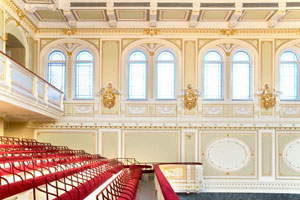 At Ekaterina II to Russia for a manual of the Italian opera the Italian composers - Sarti and Galuppi which began to compose also products of a sacred music for orthodox church on slavic texts in the Italian style were invited. Training to the "Italian" singing has borrowed strong positions in the Singing Chapel. Skill of the court choristers connecting a traditional church and Italian manner of singing, admired many, it is especial foreigners. On words Ioahima Shternberga - the German traveller, " This singing will penetrate up to depth of soul: involuntarily you feel blessing and prompting to glorification of the Highest Essence. The creative shape of the Chapel was defined always by oustanding persons of its art directors. In the beginning of a creative way management of the Chapel during several decades Italian maestros Baltazar Galuppi (teacher of Bortnjanskiy), Tomazo Traetta, Dzhovanni Panziello (composed here well-known carried out " the Seville barber "). Further with a history of the Court Singing Chapel which substantially have defined its creative destiny, Dmitry Bortnjanskogo‘s activity - " Russian Motsarta ", by the most authoritative figure in music world of Russia of that time is connected. Supervising over the Chapel with 1796 for 1825, it could create the chorus becoming glory and pride of domestic musical culture. The products created by it for chorus have lifted on extraordinary height authority of Russian singing culture. Robert Shuman after visiting Saint Petersburg marks: " the Chapel - the most fine chorus which to us should be heard: basses from time to time remind sounds of body, and trebles sound is a miracle... "
At Ekaterina II to Russia for a manual of the Italian opera the Italian composers - Sarti and Galuppi which began to compose also products of a sacred music for orthodox church on slavic texts in the Italian style were invited. Training to the "Italian" singing has borrowed strong positions in the Singing Chapel. Skill of the court choristers connecting a traditional church and Italian manner of singing, admired many, it is especial foreigners. On words Ioahima Shternberga - the German traveller, " This singing will penetrate up to depth of soul: involuntarily you feel blessing and prompting to glorification of the Highest Essence. The creative shape of the Chapel was defined always by oustanding persons of its art directors. In the beginning of a creative way management of the Chapel during several decades Italian maestros Baltazar Galuppi (teacher of Bortnjanskiy), Tomazo Traetta, Dzhovanni Panziello (composed here well-known carried out " the Seville barber "). Further with a history of the Court Singing Chapel which substantially have defined its creative destiny, Dmitry Bortnjanskogo‘s activity - " Russian Motsarta ", by the most authoritative figure in music world of Russia of that time is connected. Supervising over the Chapel with 1796 for 1825, it could create the chorus becoming glory and pride of domestic musical culture. The products created by it for chorus have lifted on extraordinary height authority of Russian singing culture. Robert Shuman after visiting Saint Petersburg marks: " the Chapel - the most fine chorus which to us should be heard: basses from time to time remind sounds of body, and trebles sound is a miracle... "
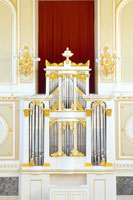 The high traditions of the Singing Chapel incorporated Bortnjanskim, successfully were continued subsequently by A.F.L‘vovym supervising the Chapel with 1836 on 1861, M.I.Glinko who has worked of a little bit years by the conductor of chorus and chorus master G.J.Lomakin. With 1861 for 1883 the manager of the Chapel becomes N.I.Bahmet‘ev, the big expert on traditions of Russian church singing. At it creation of the Court Singing Chapel which incorporated the big chorus participating in church services, open concerts and opera performances, musical school, regentskie rates, an orchestra and a small concert hall as a matter of fact was had finished. Only in 1830 the small concert hall which existed till 80th years of the last century and has much served to glorification of choral art of the Chapel was erected. Decayed buildings of the Chapel after significant efforts of a management was solved to put on major overhaul. From the letter S.D.Sheremet‘eva‘s column to stats-secretary N.S.Petrov: " Sovereign Emperor at last visiting the Court Chapel in February of this year Vysochajshe has enjoined to deign to start reorganization of buildings of the Chapel, since a construction of the concert Hall ". In 1886 on a competitive basis " Highest has deigned to approve the project of academician Benua, having enjoined: to start nowadays realization of this project ". Leonty Nikolaevich Benua was not only the author of the project of reorganization of buildings of the Chapel, but also practically during three years carried out a management of erection and furnish of cases, carried out sketches of interiors of furniture, an accessories and conducted the documentation on construction.
The high traditions of the Singing Chapel incorporated Bortnjanskim, successfully were continued subsequently by A.F.L‘vovym supervising the Chapel with 1836 on 1861, M.I.Glinko who has worked of a little bit years by the conductor of chorus and chorus master G.J.Lomakin. With 1861 for 1883 the manager of the Chapel becomes N.I.Bahmet‘ev, the big expert on traditions of Russian church singing. At it creation of the Court Singing Chapel which incorporated the big chorus participating in church services, open concerts and opera performances, musical school, regentskie rates, an orchestra and a small concert hall as a matter of fact was had finished. Only in 1830 the small concert hall which existed till 80th years of the last century and has much served to glorification of choral art of the Chapel was erected. Decayed buildings of the Chapel after significant efforts of a management was solved to put on major overhaul. From the letter S.D.Sheremet‘eva‘s column to stats-secretary N.S.Petrov: " Sovereign Emperor at last visiting the Court Chapel in February of this year Vysochajshe has enjoined to deign to start reorganization of buildings of the Chapel, since a construction of the concert Hall ". In 1886 on a competitive basis " Highest has deigned to approve the project of academician Benua, having enjoined: to start nowadays realization of this project ". Leonty Nikolaevich Benua was not only the author of the project of reorganization of buildings of the Chapel, but also practically during three years carried out a management of erection and furnish of cases, carried out sketches of interiors of furniture, an accessories and conducted the documentation on construction.
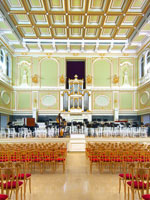 The central place in an architectural composition of the Chapel borrows the concert Hall. The architect has considered its creation with huge attention. Undoubtedly, the hall began one of main lucks the builder of the Chapel not only on external furniture, but also under the acoustic characteristics. The problem "a good resonance extremely borrowed the architect. Using effect violining decks in the ratio a floor and a ceiling, use of iron farms, that on those times was extremely courageous decision, building materials, down to a upholstery of beechen chairs, were carefully thought over. Time has proved correctness of the architect. Behind a hall of the Chapel the reputation different, and on some responses and an ideal hall in the acoustic attitude was established. Projecting L.Benua‘s concert hall planned installation of body in it. However, for some reasons the architect did not manage to carry out the plan. Only in 1927 the body transferred from the Dutch reformatory church was established. The tool was successfully entered in an interior and acoustics of a hall: it was established on a place intended for body the architect, and constructed in 1891 by firm " E. F. Walcker ". Does not weaken creative active collective. On high traditions of the Chapel were brought up and generations of the best domestic choruses continue to be brought up. Here have received A.V.Alexander‘s musical education, V.A.Dranishnikov, A.G.Fljarkovsky, A.S.Dmitriev, V.A.Chernushenko, A.A.Jurlov, D.G.Kitaenko, V.A.Atlantov and many others.
The central place in an architectural composition of the Chapel borrows the concert Hall. The architect has considered its creation with huge attention. Undoubtedly, the hall began one of main lucks the builder of the Chapel not only on external furniture, but also under the acoustic characteristics. The problem "a good resonance extremely borrowed the architect. Using effect violining decks in the ratio a floor and a ceiling, use of iron farms, that on those times was extremely courageous decision, building materials, down to a upholstery of beechen chairs, were carefully thought over. Time has proved correctness of the architect. Behind a hall of the Chapel the reputation different, and on some responses and an ideal hall in the acoustic attitude was established. Projecting L.Benua‘s concert hall planned installation of body in it. However, for some reasons the architect did not manage to carry out the plan. Only in 1927 the body transferred from the Dutch reformatory church was established. The tool was successfully entered in an interior and acoustics of a hall: it was established on a place intended for body the architect, and constructed in 1891 by firm " E. F. Walcker ". Does not weaken creative active collective. On high traditions of the Chapel were brought up and generations of the best domestic choruses continue to be brought up. Here have received A.V.Alexander‘s musical education, V.A.Dranishnikov, A.G.Fljarkovsky, A.S.Dmitriev, V.A.Chernushenko, A.A.Jurlov, D.G.Kitaenko, V.A.Atlantov and many others.
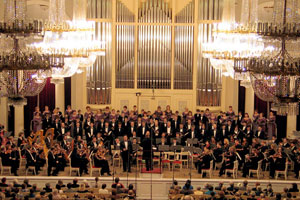 Unfortunately, after 1917 year the Chapel as the uniform establishment has gradually undergone to disintegration: the symphonic orchestra was transferred to conducting the philarmonic Society, regentskie classes have stopped the existence right after revolutions, the choral school was removed from structure of the Chapel in 50th years. It has negatively had an effect on realization of huge creative opportunities of the Chapel and on preparation of the musical staff. In 1974 the head of the Chapel becomes Vladislav Chernushenko. With its arrival the new stage in creative activity of the Chapel, connected, first of all, with revival of its primordial historical traditions begins. In short terms the chorus under its management recreates the former form and comes back in number of the best choral collectives of the world. Since 1991 the symphonic orchestra of the Chapel again started to function. On turn returning under a roof of the Chapel of choral school. Revival of chorus has incorporated to revival of Russian sacred music, in Soviet time, valid "ideologist" the culture which are taking place under an interdiction. Due to V. Chernushenko in repertoir of chorus is returned the most valuable layer of domestic culture - creations of Russian sacred music. "Liturgy" and "Night service” Chajkovskogo, “Nightlong vigil" Rahmaninov, “Passionate sedmitsa" Grechaninov, choral compositions Berezovskogo, Bortnjanskogo, Arkhangelsk, Chesnokova.
Unfortunately, after 1917 year the Chapel as the uniform establishment has gradually undergone to disintegration: the symphonic orchestra was transferred to conducting the philarmonic Society, regentskie classes have stopped the existence right after revolutions, the choral school was removed from structure of the Chapel in 50th years. It has negatively had an effect on realization of huge creative opportunities of the Chapel and on preparation of the musical staff. In 1974 the head of the Chapel becomes Vladislav Chernushenko. With its arrival the new stage in creative activity of the Chapel, connected, first of all, with revival of its primordial historical traditions begins. In short terms the chorus under its management recreates the former form and comes back in number of the best choral collectives of the world. Since 1991 the symphonic orchestra of the Chapel again started to function. On turn returning under a roof of the Chapel of choral school. Revival of chorus has incorporated to revival of Russian sacred music, in Soviet time, valid "ideologist" the culture which are taking place under an interdiction. Due to V. Chernushenko in repertoir of chorus is returned the most valuable layer of domestic culture - creations of Russian sacred music. "Liturgy" and "Night service” Chajkovskogo, “Nightlong vigil" Rahmaninov, “Passionate sedmitsa" Grechaninov, choral compositions Berezovskogo, Bortnjanskogo, Arkhangelsk, Chesnokova.
Performance of the Mansion of the Chapel spiritual singning XV - XVII v.v. (for the first time for two centuries) it is possible to attribute to opening the world scale, similar to opening of masterpieces old russian ikonwriting or the old russian literature. Beauty and riches of Russian singing culture show partesnye concerts XVII - XVIII v.v., edgings petrovskoj epoch, choral processings Russian national songs. The chapel carefully keeps and restores " gold fund "
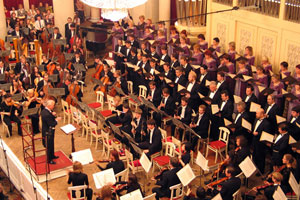 The tool was successfully entered in an interior and acoustics of a hall: it was established on a place intended for body the architect, and constructed in 1891 by firm "E. F. Walcker". Creative activity of the Chapel and after October revolution does not weaken. Renamed in 1918 in Petrograd choral Academy, and in 1922 in the Leningrad State Academic Chapel, it continues activity on propagation of musical classics. Passions on Matfeju Baha "Condemnation Fausta " Berlioza, Requiem Bramsa, "Bells" Rahmaninova, Second symphony Malera, "Orfej" Monteverdi, Requiem Bramsa, "On perusal psalma" Taneeva, "the Legend about Sacred Elizaveta" the Sheet are executed Messa h-moil and ". The important place in repertoir of chorus is borrowed also with products of modern composers. "Songs Gurre" Shenberga, quaire R.Shtrausa and Hindemita, Chesnokova and Kovalja, Davidenko and Bogdanova sound "Antigona" and "Tsar David" Oneggera, "Wedding" and "Tsar Edip" Stravinskiy. The art director and main conductor M.G.Klimov, of 15 years of the indefatigable work given out to the Chapel, has played the big role histories of life of chorus. During its management the Chapel has increased the achievements. It was confirmed with triumphal performances of the Chapel in 1928 in the largest cities of Latvia, Germany, Switzerland and Italy.
The tool was successfully entered in an interior and acoustics of a hall: it was established on a place intended for body the architect, and constructed in 1891 by firm "E. F. Walcker". Creative activity of the Chapel and after October revolution does not weaken. Renamed in 1918 in Petrograd choral Academy, and in 1922 in the Leningrad State Academic Chapel, it continues activity on propagation of musical classics. Passions on Matfeju Baha "Condemnation Fausta " Berlioza, Requiem Bramsa, "Bells" Rahmaninova, Second symphony Malera, "Orfej" Monteverdi, Requiem Bramsa, "On perusal psalma" Taneeva, "the Legend about Sacred Elizaveta" the Sheet are executed Messa h-moil and ". The important place in repertoir of chorus is borrowed also with products of modern composers. "Songs Gurre" Shenberga, quaire R.Shtrausa and Hindemita, Chesnokova and Kovalja, Davidenko and Bogdanova sound "Antigona" and "Tsar David" Oneggera, "Wedding" and "Tsar Edip" Stravinskiy. The art director and main conductor M.G.Klimov, of 15 years of the indefatigable work given out to the Chapel, has played the big role histories of life of chorus. During its management the Chapel has increased the achievements. It was confirmed with triumphal performances of the Chapel in 1928 in the largest cities of Latvia, Germany, Switzerland and Italy.
 The Berlin newspaper "Berliner vesten " those days wrote: "... Will not be exaggeration if to rank the Russian state chorus as the best choruses of the world ". Greek conductor D.Mitropulos in 1933 so responded about chorus: " Not only never слыхал anything similar to execution(performance) of the Chapel, but also did not represent, that the chorus could so sing. A chapel - the eighth miracle in the world ". Activity of the Chapel and within Great Domestic war does not stop. Evacuated in 1941 in city of Kirov, chorus acted in military units, in hospitals, at factories and factories, acted with concerts in cities of the Volga region, Siberia, Central Asia. In post-war year the Chapel has returned to students such masterpieces of world and Russian classics, as " Requiem "Motsarta", Samson "Gendelja", Seasons "Gajdna", Spring "Rahmaninova", Moscow "Chajkovskogo", Ioan Damaskin " Taneeva. In different years of a mansion such oustanding musicians, as over A.V.Sveshnikov, G.A.Dmitrievsky, A.I.Anisimov, E.G.Kudrjavtseva, F.M.goat, brought in the contribution to work of collective supervised. On high traditions of the Chapel were brought up and generations of the best domestic choruses continue to be brought up. Here have received A.V.Alexander‘s musical education, V.A.Dranishnikov, A.G.Fljarkovsky, A.S.Dmitriev, V.A.Chernushenko, A.A.Jurlov, D.G.Kitaenko, V.A.Atlantov and many others. Unfortunately, после1917 year the Chapel as the uniform establishment has gradually undergone to disintegration: the symphonic orchestra was transferred to conducting the philarmonic Society, regentskie classes have stopped the existence right after revolutions, the choral school was deduced from structure of the Chapel in 50th years. It has negatively had an effect on realization of huge creative opportunities of the Chapel and on preparation of the musical staff. In 1974 the head of the Chapel becomes Vladislav Chernushenko. With its arrival the new stage in creative activity of the Chapel, connected, first of all, with revival of its primordial historical traditions begins. In short terms the chorus under its management recreates the former form and comes back in number of the best choral collectives of the world.
The Berlin newspaper "Berliner vesten " those days wrote: "... Will not be exaggeration if to rank the Russian state chorus as the best choruses of the world ". Greek conductor D.Mitropulos in 1933 so responded about chorus: " Not only never слыхал anything similar to execution(performance) of the Chapel, but also did not represent, that the chorus could so sing. A chapel - the eighth miracle in the world ". Activity of the Chapel and within Great Domestic war does not stop. Evacuated in 1941 in city of Kirov, chorus acted in military units, in hospitals, at factories and factories, acted with concerts in cities of the Volga region, Siberia, Central Asia. In post-war year the Chapel has returned to students such masterpieces of world and Russian classics, as " Requiem "Motsarta", Samson "Gendelja", Seasons "Gajdna", Spring "Rahmaninova", Moscow "Chajkovskogo", Ioan Damaskin " Taneeva. In different years of a mansion such oustanding musicians, as over A.V.Sveshnikov, G.A.Dmitrievsky, A.I.Anisimov, E.G.Kudrjavtseva, F.M.goat, brought in the contribution to work of collective supervised. On high traditions of the Chapel were brought up and generations of the best domestic choruses continue to be brought up. Here have received A.V.Alexander‘s musical education, V.A.Dranishnikov, A.G.Fljarkovsky, A.S.Dmitriev, V.A.Chernushenko, A.A.Jurlov, D.G.Kitaenko, V.A.Atlantov and many others. Unfortunately, после1917 year the Chapel as the uniform establishment has gradually undergone to disintegration: the symphonic orchestra was transferred to conducting the philarmonic Society, regentskie classes have stopped the existence right after revolutions, the choral school was deduced from structure of the Chapel in 50th years. It has negatively had an effect on realization of huge creative opportunities of the Chapel and on preparation of the musical staff. In 1974 the head of the Chapel becomes Vladislav Chernushenko. With its arrival the new stage in creative activity of the Chapel, connected, first of all, with revival of its primordial historical traditions begins. In short terms the chorus under its management recreates the former form and comes back in number of the best choral collectives of the world.
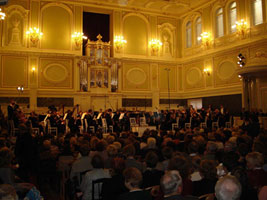 Since 1991 the symphonic orchestra of the Chapel again started to function. On turn returning under a roof of the Chapel of choral school. Revival of chorus has incorporated to revival of Russian sacred music, in Soviet time, valid "ideolisation" the culture which are taking place under an interdiction. Due to V. Chernushenko in repertoir of chorus is returned the most valuable layer of domestic culture - creations of Russian sacred music. " Liturgy "и" Night service "Chajkovskogo", Nightlong vigil "Rahmaninova", Passionate sedmitsa " Grechaninova, choral compositions Berezovskogo, Bortnjanskogo, Arkhangelsk, CHesnokova. Performance of the Mansion of the Chapel spiritual pesnopeny XV - XVII v.v. (for the first time for two centuries) it is possible to attribute to opening the world scale, similar to opening of masterpieces old russian ikonowriting or the old russian literature. Beauty and riches of Russian singing culture show partesnye concerts XVII - XVIII v.v., edgings petrovskoj epoch, choral processings Russian national songs. The chapel carefully keeps and restores " gold fund " classical repertoir. Requiem Mo tsarta, Ninth symphony Bethovena, Requiem Verdi, " Passions on John " Baha, Big messa Motsarta, " John Damaskin "Taneeva", Bells "Rahmaninova", Moscow " Chajkovskogo - these creations of masters of the past and today in repertoir of collective. The creative orientation of work of collective to be under construction in view of a wide structure of activity of the Chapel which during all long history was ensemble, with equal skill in taking part large kantatno - oratorial compositions with support of an orchestra, product for chorus a capella, symphonic products. Such multiplane range of repertoir became possible with restoration of activity of a symphonic orchestra in 1991 (the main conductor - Alexander Chernushenko).
Since 1991 the symphonic orchestra of the Chapel again started to function. On turn returning under a roof of the Chapel of choral school. Revival of chorus has incorporated to revival of Russian sacred music, in Soviet time, valid "ideolisation" the culture which are taking place under an interdiction. Due to V. Chernushenko in repertoir of chorus is returned the most valuable layer of domestic culture - creations of Russian sacred music. " Liturgy "и" Night service "Chajkovskogo", Nightlong vigil "Rahmaninova", Passionate sedmitsa " Grechaninova, choral compositions Berezovskogo, Bortnjanskogo, Arkhangelsk, CHesnokova. Performance of the Mansion of the Chapel spiritual pesnopeny XV - XVII v.v. (for the first time for two centuries) it is possible to attribute to opening the world scale, similar to opening of masterpieces old russian ikonowriting or the old russian literature. Beauty and riches of Russian singing culture show partesnye concerts XVII - XVIII v.v., edgings petrovskoj epoch, choral processings Russian national songs. The chapel carefully keeps and restores " gold fund " classical repertoir. Requiem Mo tsarta, Ninth symphony Bethovena, Requiem Verdi, " Passions on John " Baha, Big messa Motsarta, " John Damaskin "Taneeva", Bells "Rahmaninova", Moscow " Chajkovskogo - these creations of masters of the past and today in repertoir of collective. The creative orientation of work of collective to be under construction in view of a wide structure of activity of the Chapel which during all long history was ensemble, with equal skill in taking part large kantatno - oratorial compositions with support of an orchestra, product for chorus a capella, symphonic products. Such multiplane range of repertoir became possible with restoration of activity of a symphonic orchestra in 1991 (the main conductor - Alexander Chernushenko).
 Programs of creative collectives of the Chapel are sated and interesting: " Karmina the Buran " Orfa, the symphony №3 "Kad" Bernstajna, concert execution of operas " Aleko "и" Virineja " Slonimskogo, compositions Chajkovskogo, Prokof‘eva, SHostakovicha, modern Russian composers Sviridova, Tishchenko, Falika. Are restored after oblivion Music on crowning of Napoleon in 1804 - "Solemn messa" Panziello, historical representation " Oleg‘s Initial management " which libretto were written by Ekaterina II on E.Pashkevacha‘s music, D.Sarti, To Konobbio (V.A.Chernushenko‘s author‘s edition). The high performing level of skill, various repertoir allow the Singing Chapel and a symphonic orchestra of the Chapel much and is amplified to go on tour. To art of the Chapel clapped almost in all countries of Europe, Japan, Korea. Last years is amplified strengthened revival of the Chapel as one of the centres of the European musical culture is carried out. On a stage of the concert Hall of the Chapel oustanding instrumentalists, singers, conductors of the modernity act. The body of the Chapel under the right is considered from the best in Europe and involves the best organists of the world. In the Chapel the International musical festivals will be carried out, many of which became traditional: " Festival organ music "," Shubertiady "," the Neva choral assemblies "," the Finno-Russian musical festival "," it Is simple friends " and others. With each year the increasing amount of musical collectives and soloists accept in them participation. In 2003 the Chapel of Saint Petersburg will celebrate the 300-anniversary. Long, interesting, useful life is lived. Its history is a history Russian musical the claim usstva. Its present based on to the maximal realization of the richest creative resources, the sure realization of the creative intentions. The history of the Chapel, as a matter of fact, is a history of origin, becoming and development of domestic musical culture. Already about three centuries, the Chapel, reflecting and substantially forming the person of the russko-European St. Petersburg, renders huge influence on ways of development of Russian music. And today, at the end of XX century, chardge of the National actor, the Winner the State premiums, professor V.A. Chernushenko, the Chapel continues to bear high traditions and glory of Russian musical culture, as much as possible realizing the richest creative plans.
Programs of creative collectives of the Chapel are sated and interesting: " Karmina the Buran " Orfa, the symphony №3 "Kad" Bernstajna, concert execution of operas " Aleko "и" Virineja " Slonimskogo, compositions Chajkovskogo, Prokof‘eva, SHostakovicha, modern Russian composers Sviridova, Tishchenko, Falika. Are restored after oblivion Music on crowning of Napoleon in 1804 - "Solemn messa" Panziello, historical representation " Oleg‘s Initial management " which libretto were written by Ekaterina II on E.Pashkevacha‘s music, D.Sarti, To Konobbio (V.A.Chernushenko‘s author‘s edition). The high performing level of skill, various repertoir allow the Singing Chapel and a symphonic orchestra of the Chapel much and is amplified to go on tour. To art of the Chapel clapped almost in all countries of Europe, Japan, Korea. Last years is amplified strengthened revival of the Chapel as one of the centres of the European musical culture is carried out. On a stage of the concert Hall of the Chapel oustanding instrumentalists, singers, conductors of the modernity act. The body of the Chapel under the right is considered from the best in Europe and involves the best organists of the world. In the Chapel the International musical festivals will be carried out, many of which became traditional: " Festival organ music "," Shubertiady "," the Neva choral assemblies "," the Finno-Russian musical festival "," it Is simple friends " and others. With each year the increasing amount of musical collectives and soloists accept in them participation. In 2003 the Chapel of Saint Petersburg will celebrate the 300-anniversary. Long, interesting, useful life is lived. Its history is a history Russian musical the claim usstva. Its present based on to the maximal realization of the richest creative resources, the sure realization of the creative intentions. The history of the Chapel, as a matter of fact, is a history of origin, becoming and development of domestic musical culture. Already about three centuries, the Chapel, reflecting and substantially forming the person of the russko-European St. Petersburg, renders huge influence on ways of development of Russian music. And today, at the end of XX century, chardge of the National actor, the Winner the State premiums, professor V.A. Chernushenko, the Chapel continues to bear high traditions and glory of Russian musical culture, as much as possible realizing the richest creative plans.
State Academic Chapel hall plan

Address: Quay of the river Moyka 20
Complete schedule of all St. Petersburg theatres 2022
     
|



